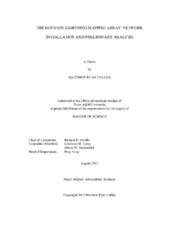| dc.description.abstract | The Houston Lightning Mapping Array (LMA) is a lightning detection network providing total lightning mapping for the Houston metropolitan area and southeast Texas. The network is comprised of twelve Very High Frequency (VHF) time-of-arrival total lightning mapping sensors built by New Mexico Institute of Mining and Technology and purchased by Texas A&M University. The sensors, installed in April 2012, are of the latest, modular design and built to be independent stations that utilize a solar panel for electricity and cellular data modems for communication. Each sensor detects the time of arrival of a VHF impulse emitted as part of the electrical breakdown and lightning propagation process. Data from each sensor are processed on a central LMA server to provide three-dimensional mapping of these impulses, also called LMA sources. This processing facilitates the analysis of variations in thunderstorm structure and the associated changes in both space and time.
The primary objectives for the installation of the Houston LMA network are twofold: first, to provide a dataset enabling research into thunderstorm electrification in the context of a coastal, urban, polluted environment; and second, to enable improvements in operational forecasting and public safety by providing total lightning data to partners including the National Weather Service (NWS). A workflow was established to create and share real-time data to these partners, while simultaneously maintaining a full, research-quality dataset. Data are retrieved from the field sensors and backed up to a central LMA server for processing and storage. Archived network data are available from July 2012 through the present. The network measures 150 km from north to south, with stations in College Station and Galveston complementing the ten sites surrounding downtown Houston. This extends the region constrained by the network beyond the immediate metropolitan Houston area, resulting in increased accuracy in locating sources further from the network center. Based on initial analyses, the effective range of the Houston LMA is 75 km for three-dimensional mapping and approximately 250 km for two-dimension mapping. | en |


